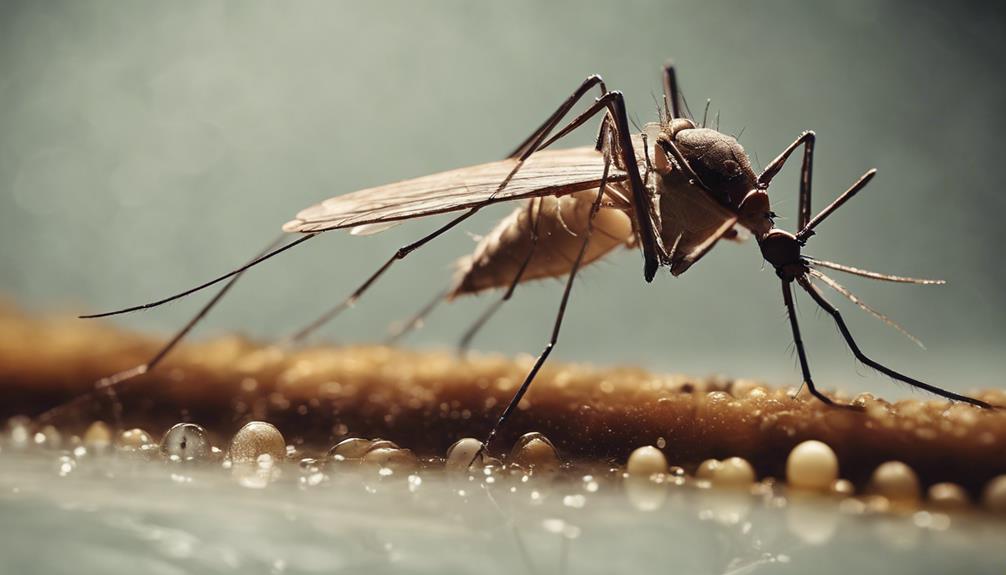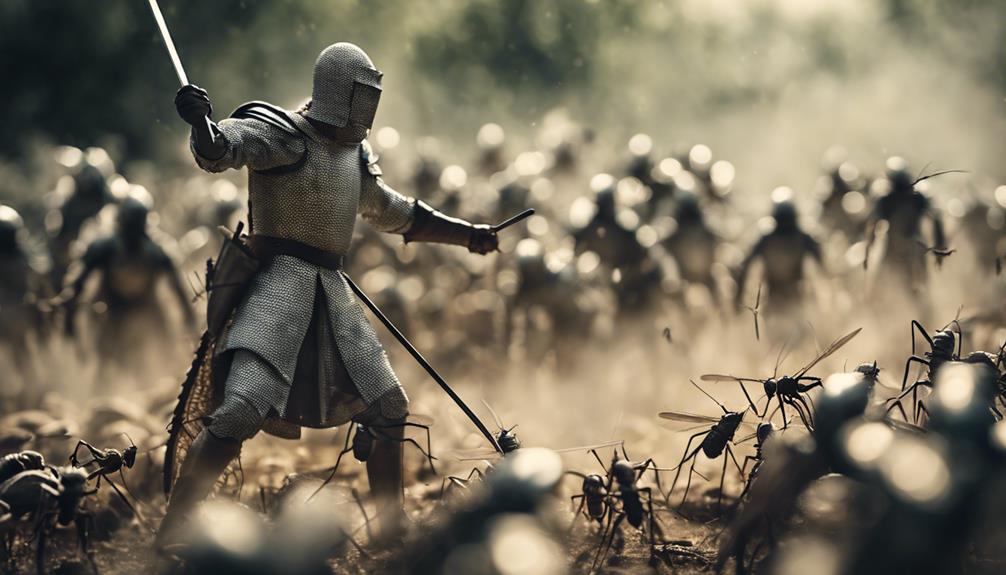To break the cycle of mosquitoes, start at the beginning. Eggs are laid on water. Larvae feed on tiny organisms and hang from water surfaces. Pupae have unique breathing structures. Adults emerge, seeking blood for egg-laying. Control methods target eggs and larvae on water. Larvicides help reduce larvae. Prevent adult emergence using traps and repellents. Mosquitoes spread diseases like Zika and malaria. Understand transmission to prevent. Eliminate standing water and larvae to hinder breeding. Use screens and repellents to deter adults. Protective measures aid in disease prevention. Learning more about mosquito stages can guide effective control efforts.
Key Takeaways
- Eggs laid on water surface or in flood-prone areas
- Larvicides target larvae to control population
- Prevent adult mosquito emergence to reduce numbers
- Use traps, insecticides, and natural repellents
- Implement physical barriers and biological control methods
Importance of Understanding Mosquito Life Cycle
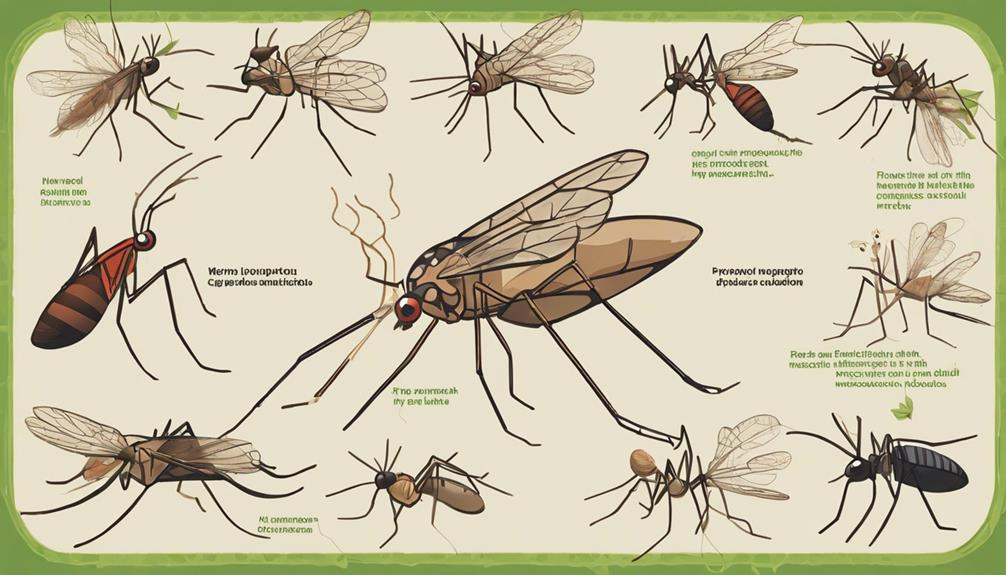
Understanding the mosquito life cycle is essential for developing targeted and effective control strategies to combat these disease-carrying pests. Mosquitoes go through four stages in their life cycle: egg, larva, pupa, and adult. Different species of mosquitoes have unique breeding habitats, with some preferring stagnant water sources like ponds, while others thrive in containers like flower pots.
By knowing where mosquitoes breed, such as in standing water or damp soil, control measures can be implemented to disrupt their life cycle. Eliminating breeding sites through proper waste disposal, covering water storage containers, and using larvicides are critical control measures. Breaking the mosquito life cycle at the larvae and pupae stages can prevent the emergence of adult mosquitoes, reducing their population.
Having a thorough understanding of the mosquito life cycle is important for designing effective strategies to manage and diminish mosquito populations, ultimately decreasing the risk of diseases they transmit.
Egg Stage: Where It All Begins
In the lifecycle of mosquitoes, the egg stage marks the important beginning of their development process. Mosquito eggs are typically laid individually or in rafts on the surface of water or in flood-prone areas, ensuring a suitable environment for their survival. The location of the eggs on the water surface is critical for their development. Some species’ eggs can hatch within a few days, while others may remain dormant for an extended period, awaiting the right conditions to hatch. Factors such as temperature play a significant role in determining the hatching time of mosquito eggs, with warmer temperatures accelerating the process.
Certain mosquito species have adapted mechanisms where their eggs can survive dry conditions until they come into contact with water, triggering the hatching process. Understanding the behavior and characteristics of mosquito eggs is essential in disrupting the mosquito life cycle and curbing their population growth. By targeting the eggs laid on water surfaces and preventing them from hatching, you can effectively break the cycle and reduce the mosquito population in your surroundings.
Larval Development and Behavior
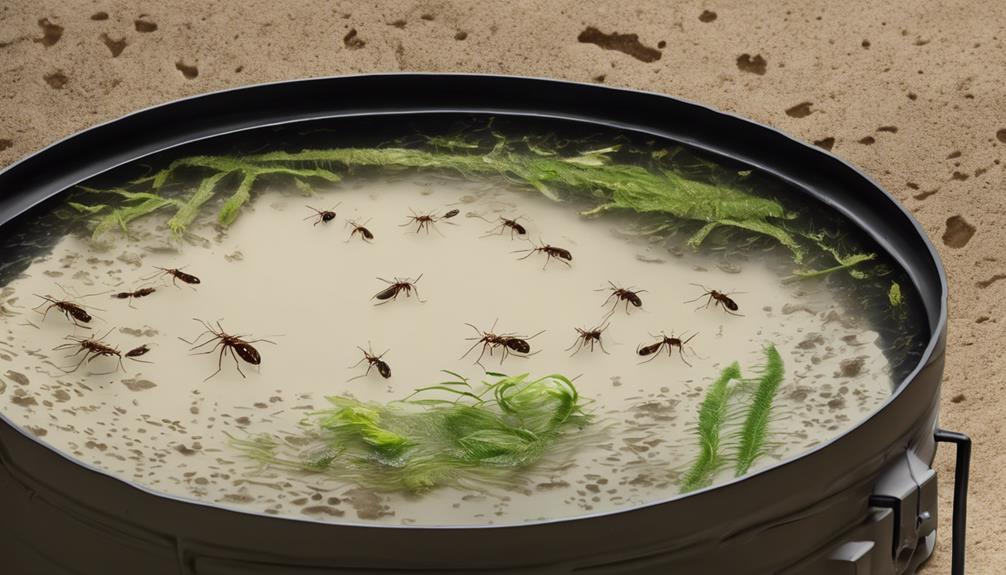
Moving forward in the mosquito lifecycle, the focus now shifts to the larval development and behavior, shedding light on pivotal aspects of their growth and habits.
- Mosquito larvae hang suspended from the water surface using a breathing tube.
- Larvae feed on microscopic organisms present in the water.
- Larvae molt through several instars during their development.
- The larval stage of mosquitoes typically lasts between 4 to 14 days.
- Mosquito larvae are highly sensitive to disturbances and light.
During the larval stages, mosquitoes exhibit fascinating behaviors and adaptations. They’re adept at hanging from the water surface using a specialized breathing tube, allowing them to access oxygen while feeding on tiny organisms in their breeding sites.
As they progress through multiple molting stages, their sensitivity to disturbances and light guides their behavior, helping them avoid potential threats and survive in their aquatic environments. Understanding these aspects of mosquito behavior during the larval stages is essential for effective mosquito control strategies.
Pupal Transformation Process
The pupal metamorphosis process marks a critical stage in the lifecycle of mosquitoes, signifying the shift from larva to adult mosquito. During the pupal stage, which typically lasts between 1 1/2 to 4 days, the larva undergoes significant internal changes to transform into an adult mosquito.
Pupae have specialized structures that allow them to breathe air at the water surface, vital for their development. They’re sensitive to light and disturbances, often exhibiting a rolling action to evade potential threats. Unlike the larval stage, no feeding occurs during the pupal stage as the mosquito prepares for its emergence as an adult.
This period is essential for the mosquito to complete its development and emerge as a fully formed adult mosquito ready to continue the lifecycle. Understanding the pupal transformation process is crucial in comprehending the intricate stages of mosquito development and can aid in effectively breaking the mosquito lifecycle to control populations.
Emergence of Adult Mosquitoes
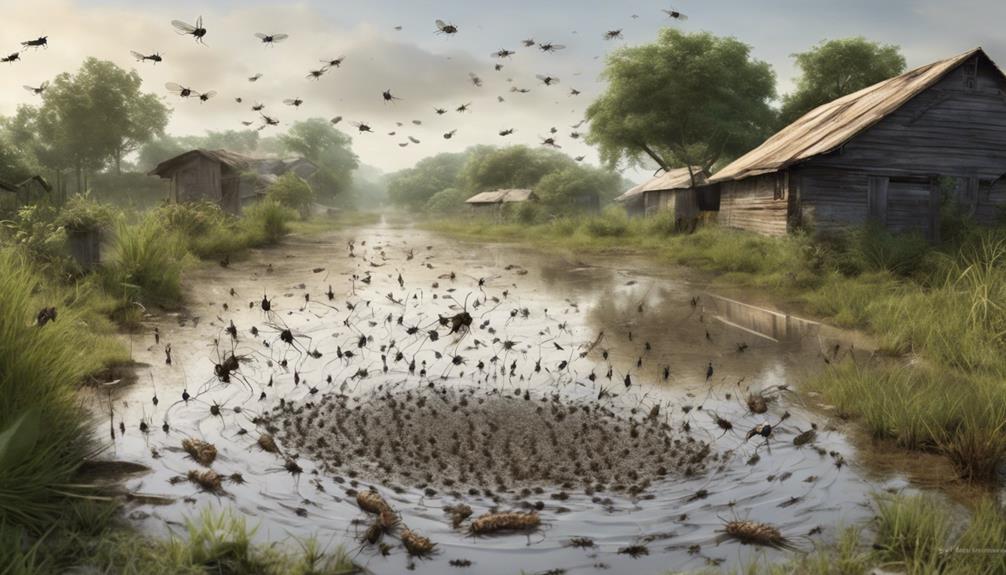
When adult mosquitoes emerge, their bodies have undergone hardening during the pupal stage.
Females typically appear after males and promptly seek a blood meal to facilitate egg-laying.
Understanding the feeding habits and lifespan differences between male and female mosquitoes can aid in population control measures.
Adult Mosquito Appearance
Emerging from the pupal stage, adult mosquitoes signify the culmination of the mosquito life cycle. When it comes to their appearance, adult mosquitoes exhibit fascinating characteristics:
- Female mosquitoes require a blood meal to lay eggs after becoming adults.
- Adult mosquitoes have fully developed wings and can fly.
- Adult mosquitoes have a short lifespan, with females living longer than males.
- The body of an adult mosquito is divided into three sections: head, thorax, and abdomen.
- Female mosquitoes have mouthparts suitable for piercing skin and sucking blood, while males feed on nectar and plant juices.
Mating and Reproduction
Upon reaching adulthood, mosquitoes engage in an essential process known as mating for reproduction. Male mosquitoes emerge first and promptly seek out females for mating after the pupal stage. Mating occurs when a male mosquito transfers sperm to a female mosquito, enabling her to fertilize her eggs.
Once fertilized, the female mosquito seeks a blood meal to provide the necessary nutrients for egg development. After obtaining a blood meal, the female mosquito lays a significant number of eggs in standing water, starting a new generation of mosquitoes. This vital step in the mosquito lifecycle guarantees the continuation of the species.
Female mosquitoes can lay eggs multiple times during their lifespan, contributing to the perpetuation of the mosquito population.
Feeding Habits and Lifespan
Adult mosquitoes, particularly females, exhibit distinct feeding habits and varying lifespans that have a significant impact on their role in the ecosystem. Female adult mosquitoes emerge after males, living up to 6 weeks and surviving up to 5 months with blood meals. Here are some key points about the feeding habits and lifespan of adult mosquitoes in the mosquito life cycle:
- Adult male mosquitoes have a short lifespan of about 6-7 days.
- High mortality rates in adults contribute to their short lifespan.
- Females lay a large number of eggs throughout their life to guarantee mosquito population continuation.
- Adult mosquitoes play an important role in the reproduction and spread of mosquitoes in the environment.
- Controlling adult mosquito populations is essential in mosquito control efforts.
Disease Transmission by Mosquitoes
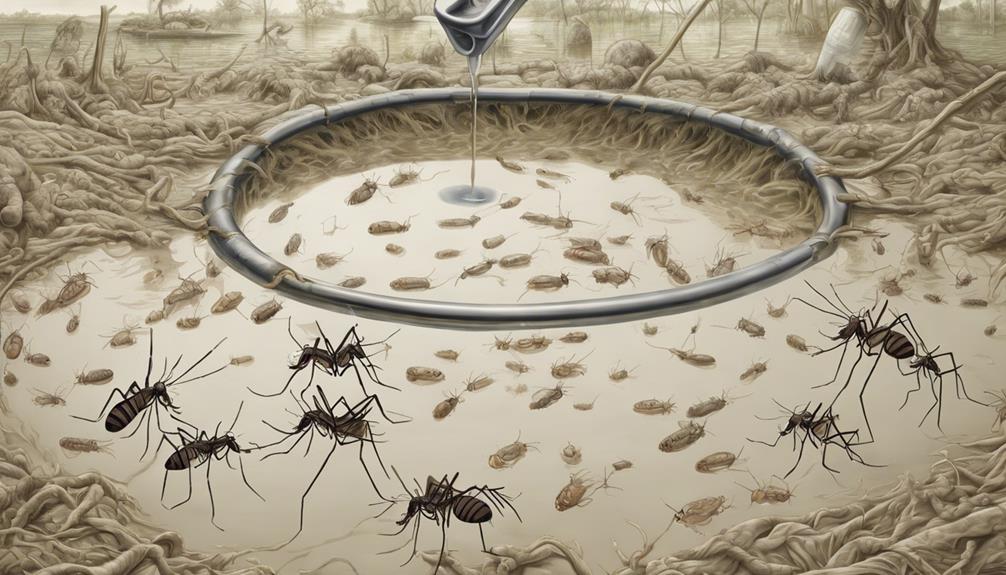
Mosquitoes can transmit diseases such as Zika, dengue, malaria, and West Nile virus through infected bites. When an infected mosquito feeds on a host, it can pass on the disease-causing pathogens.
These illnesses can lead to symptoms like fever, joint pain, and neurological complications, underscoring the importance of controlling mosquito populations to prevent disease transmission.
Mosquito-Borne Illnesses Overview
In the domain of public health, a crucial concern lies in the thorough understanding of how diseases are transmitted by mosquitoes. Female mosquitoes play a vital role in disease transmission through their bites while seeking blood meals.
Mosquito-borne illnesses such as Zika, dengue, malaria, and West Nile virus pose significant global health risks. Understanding the lifecycle stages, from the female mosquito laying eggs in standing water to the larval and pupal stages, is essential in combating the spread of these diseases.
Effective control and prevention measures can be implemented by targeting mosquito populations and their breeding grounds. By controlling these vectors, the transmission of dangerous diseases can be significantly reduced.
- Female mosquitoes spread diseases through blood-feeding bites.
- Mosquito-borne illnesses include Zika, dengue, malaria, and West Nile virus.
- Lifecycle stages involve egg laying in standing water, larval, and pupal development.
- Understanding transmission cycles aids in implementing prevention strategies.
- Controlling mosquito populations helps curb disease spread.
Preventing Disease Transmission
Understanding the mechanisms behind disease transmission by mosquitoes is essential for implementing effective prevention strategies. Female mosquitoes like Aedes aegypti and Anopheles lay their eggs in stagnant water, which hatch into larvae and then develop into adult mosquitoes. When these adult mosquitoes feed on blood, they can transmit diseases like Zika, dengue, and malaria to humans.
Disease transmission occurs through the mosquito’s saliva, which contains pathogens from previous infected hosts. To prevent disease transmission, it’s vital to control mosquito populations by eliminating standing water where mosquitoes breed and using protective measures such as wearing long sleeves and using insect repellents. By disrupting the lifecycle of disease-carrying mosquitoes, we can notably reduce the risk of mosquito-borne illnesses.
Strategies for Mosquito Population Control
To effectively control mosquito populations, one must employ a combination of preventative measures and targeted interventions aimed at disrupting their breeding and reproductive cycles.
Here are some strategies for mosquito population control:
- Eliminate Standing Water: Prevent the breeding of mosquitoes by getting rid of any stagnant water around your living spaces.
- Use Larvicides: Target mosquito larvae in water sources with larvicides or biological control methods to disrupt their development.
- Implement Physical Barriers: Install screens and nets to keep adult mosquitoes out of indoor areas, reducing the chances of bites and breeding indoors.
- Utilize Mosquito Traps and Insecticides: Strategically place traps and use insecticides to decrease adult mosquito populations in targeted areas.
- Incorporate Natural Repellents: Use natural repellents and essential oils to deter mosquitoes from biting and laying eggs, providing an additional layer of protection.
Frequently Asked Questions
How Do You Break the Life Cycle of a Mosquito?
To disrupt the mosquito life cycle, you must mobilize nature’s warriors. Employ natural predators, manipulate the environment, and employ biological control methods. By doing so, you interrupt their lifecycle, reducing their numbers effectively.
What Is Required for Mosquitoes to Complete Their Life Cycle?
To complete their life cycle, mosquitoes need water sources for breeding. In these aquatic habitats, larvae develop into pupae and then adults. Preventing stagnant water accumulation disrupts this cycle, reducing mosquito populations and potential diseases.
How Many Days Does It Take a Mosquito to Complete Its Life Cycle?
In the mosquito’s life cycle, it takes about 7-10 days to go from egg to adult. Factors like temperature and water quality play a role in this process. Understanding these stages is key for control strategies.
Which Stage Is the Easiest to Kill Mosquito?
To kill mosquitoes easily, focus on larval control. Target larvae in standing water with larvicides. Prevent them from becoming adults to disrupt the life cycle effectively. Larval control is important for reducing mosquito populations.

